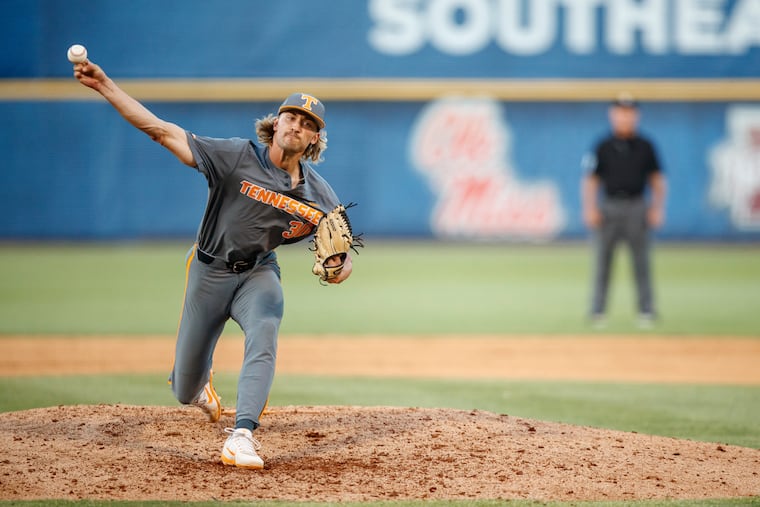Phillies stockpile relief pitchers in draft, pick hard-throwing Andrew Schultz out of Tennessee
Schultz’s fastball can reach 100 mph and would fit into the back of a major-league bullpen. It also inspires enough hope that his command can be fine-tuned in the minors.

Andrew Schultz heard the crowd gasp when his blazing fastball smacked the catcher’s mitt at an early-season college tournament.
The University of Tennessee right-hander, whom the Phillies drafted Tuesday in the sixth round, had worked tirelessly throughout the winter to alter his mechanics from a funky delivery to a simple throwing motion that maximized his velocity. And the crowd’s reaction in March let him know he was on the right track.
“I turned around and saw that it said 99 on the scoreboard,” Schultz said. “And I said, ‘Well, that isn’t all I have.’”
He loaded up another fastball, fired it to home plate, and saw triple digits flash on the board. He had reached 100 mph for the first time in his career. The crowd gave him a standing ovation, and even the opposing players cheered from their dugout.
For Schultz, it was the start of a season as one of college baseball’s hardest-throwing pitchers. He worked out of the bullpen for the Volunteers and overpowered batters with a high-90s fastball complemented by a power slider. His fastball continued to touch triple digits after that game on the Florida Panhandle. He struck out 39 batters this season in 25 innings over 26 games. Opposing hitters batted just .191 against him.
But he also walked 22 batters, as he was challenged at times to harness his velocity. And that is how he seemed to fit into the Phillies’ draft strategy as they stockpiled power arms, valuing velocity over pinpoint command. A powerful fastball such as Schultz’s would fit into the back of a major-league bullpen, and it inspires enough hope that his command can be fine-tuned in the minors.
“I’ve come to really like it,” Schultz said of moving to the bullpen. “Honestly, I think I’d prefer it. You’re in every game and you get the chance to help. That’s pretty awesome.”
Two rounds before Schultz, the Phillies selected Erik Miller, who started at Stanford but is thought to be a better fit for the bullpen, with his high-90s fastball, 6-foot-5 frame, and strong, two-pitch repertoire. That profile was enough to overlook a rate of 4.79 walks per nine innings.
After drafting hard-throwing Minnesota closer Brett Schulze in the seventh round on Tuesday, 11 rounds later, they added his left-handed teammate, Nick Lackney, who saw his velocity spike this season when he moved to the bullpen after his first start. The Phillies selected Chris Micheles, a left-handed reliever from Washington, who used a powerful fastball to strike out 76 batters in 52 1/3 innings.
“It’s how the game’s heading,” Schultz said. “In all aspects, people want to see the ball hit far and thrown hard. I kind of fit into that role, which is nice.”
The Phillies began Wednesday’s final day by drafting two high-school outfielders: Marcus Lee Sang from Maryland in the 11th round and Jadiel Sanchez from Puerto Rico in the 12th. The 13th round brought them Hunter Markwardt, who had a .996 OPS this season as the leadoff hitter for Division II Oklahoma Christian. They drafted Missouri junior Chris Cornelius, who has been the Tigers’ everyday shortstop since his freshman year and batted .326 this year, a 76-point increase from last season. They drafted Micah Yonamine, a power-hitting high-school catcher from Honolulu and intriguing junior-college right-hander Adam Leverett, who struck out 83 batters in 71 innings and impressed the Phillies last week at a workout at Citizens Bank Park.
Baseball front offices, over the last few seasons, have placed an added emphasis on relief pitchers. Starting pitchers are pitching shorter than ever, as managers use their bullpen to control the late innings. Teams are investing in relievers almost as much as they are their rotations.
But it can also be dangerous. The Phillies spent nearly $60 million on three veteran relievers over the last two winters. All three — Pat Neshek, David Robertson, and Tommy Hunter — are on the injured list, serving the Phillies as a reminder of just how fragile veteran arms can be.
So the Phillies, after spending financial capital on the bullpen, designated a significant amount of their draft capital to the bullpen. The college arms the Phillies drafted this week come tested from major programs. If they have success in the minors, it is easy to imagine their moving to the majors fairly quickly. Some of them will fail.
But the Phillies drafted enough to find a hit. And if it works, the Phillies will have to take fewer risks on veteran arms.
“I still threw hard before, but it was inconsistent,” Schultz said of reworking his mechanics. “Nothing was ever really the same. Some days, the velocity would be super high. Some days, it would be lower. I just never had a good explanation for it."
Get insights on the Phillies delivered straight to your inbox with Extra Innings, our newsletter for Phillies fans by Matt Breen, Bob Brookover and Scott Lauber. Click here to sign up.